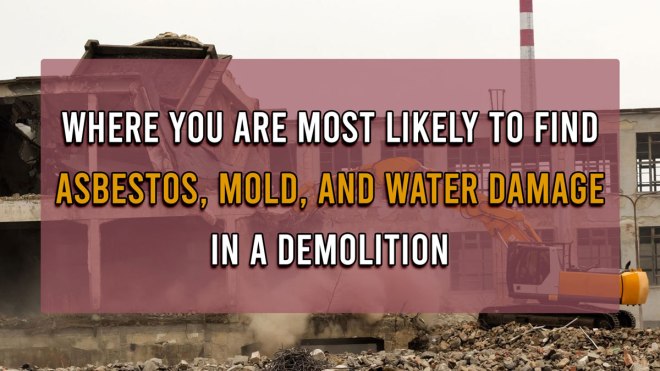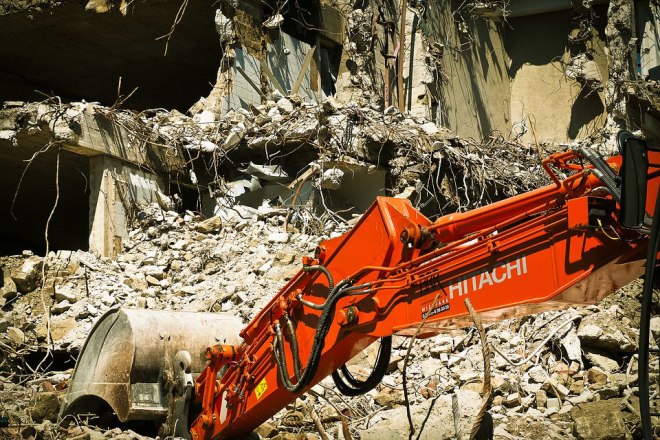Completing demolitions and deconstructions, you occasionally find materials that contain asbestos, mold, or that are plagued with water damage. These construction materials usually aren’t salvageable and need to be disposed of in a very specific way.
A lot of homeowners and property managers may not even be aware that there are mold-containing materials on-site. Prior to completing a deconstruction of any kind, it is important to conduct an analysis of what’s being torn down. This will hopefully help to distinguish between materials which can be recycled and what cannot.

Where will I find asbestos in a home or building?
Asbestos is most commonly found in cement mixed with asbestos fibres. These are known as asbestos cement, fibro, low density fiber boards, or AC sheeting. Any building component stamped with ‘AC’ may contain up to 40 percent asbestos so beware. Why asbestos and cement are such a dangerous combination is because as they age, they become dust. This means anyone can breathe it in. Here are some other areas where you find asbestos in a home for demolition.
Textured coatings.
Sprayed coatings on walls, beams, and columns.
The aforementioned asbestos in construction cement used to be applied in finishings, insulation, joinings, masonry, and toppings.
Older tiles and vinyl floors can sometimes contain asbestos.
Asbestos insulating boards.
Older sealants and adhesives – things like sticky tape and duct tape – can contain trace amounts of asbestos.
There could also be loose asbestos in the ceiling or floor cavity, something which is often discovered in older homes during demolitions and renovations.
Where will I find mold in a demolition?
Mold is a fungi. It develops in places that are typically damp or wet, warm, and surrounded by humid conditions. If you have wet or damp areas in the home, it is likely you have mold that’s growing somewhere. Mold’s relatively small and can be hidden in holes or cracks. Oftentimes, we’re completely unaware of our exposure to mold. The most common areas to find mold is bathrooms, walls, under carpet, and in basements and attics.
What are common mold types you’ll find in a renovation or demolition?
If you’re deconstructing or taking apart a home, there are several types of mold you very well may find.
Stachybotrys, otherwise known as ‘black mold’ is the most common type of toxic mold discovered in demolitions. Though it resembles black, on further examination, it is actually closer to a green-ish black.
Cladosporium is a type of mold that is known to cause allergic reactions among human beings. For this reason, cladosporium is discovered quicker than other mold types if someone’s living in the home.
Penicillium is a type of mold that is blue-ish in color and is considered a food contaminant.
Alternaria can appear as black or gray mold, is easily discovered on examination, and is known to be the cause of allergic reactions.
Aspergillus is a type of mold that can appear in a number of different colors. If you have a compromised immune system, aspergillus can cause severe harm.
Where am I likely to find water damage in a demolition?
A demolition can bring to light materials that have been water-damaged. This is most likely to occur in attics and basements. The attic, for example, doesn’t see much traffic. Though attics make a great storage space, they can also be damaged by leaks in the roof which can subsequently cause mold issues. You wouldn’t be none the wise either because we visit so rarely.
Basements and crawl spaces are also prone to water damage, as the lowest point of your property. Hard rains bring water that, if the ground doesn’t soak it up, can find their way in. Foundations can deteriorate and allow water to flow underneath a home. A plumbing leak can also potentially create a leak.
Water damaged materials in a demolition can sometimes be salvaged but not always. Some otherwise recyclable materials can be ruined depending on the condition. If you have any concerns, it’s best to speak with a waste disposal and demolition expert such as Core Mini Bins who are more than happy to answer any questions you may have.
What is deconstruction?
If you want a demolition to simply knock down a property and clear the site, this is easily accomplished but it is a little dated. These days, more demolition contractors are moving to becoming deconstructionists. What we mean by this is that ‘deconstruction’ is the act of dismantling a building with the singular goal of maximizing the recycling value of materials removed.
Deconstruction is an eco-friendly version of demolitions. The great thing about a deconstruction is that, in some cases, mold, water damaged materials, and asbestos is carefully removed and doesn’t affect the value of the rest of the materials.
Whether you choose a deconstruction or a more classic version of a demolition, the resulting demolition waste will be broken down into smaller, more manageable pieces and then sorted and/or salvaged, or sent to the landfill if they don’t possess any long-term value. There are numerous factors that go into what kind of demolition your project may require, from one’s schedule to the cost of recycling and more.
How do I maximize the recyclability of my demolition materials?
It is estimated that on average 75 percent of waste materials collected from a Toronto demolition’s recyclable. A great way to maximize how much of your demolition you recycle begins with the list below.
List all materials onsite before the demolition commences, identifying any hazardous materials or materials which you believe are rendered unrecyclable.
Identify any salvaging or recycling opportunities that may exist before you start the demolition.
Connect with facilities in the local area that accept the materials you’re going to create through your renovation or demolition.
Connect with a demolition contractor committed to recycling, reusing, and minimizing landfill waste. Core Mini Bins handles everything from demolition to waste disposal, dumpster rentals, junk removal, and more. We have a lot of relationships with facilities in the area, allowing you to minimize what has to be sent to the landfill.
There’s so much that can be reused from a demolition or renovation, including appliances, architectural details, concrete, bricks, carpet, asphalt, aggregates, drywall, electrical components, doors, windows, cabinets, countertops, gates, railings, glass, heating and cooling systems, light fixtures, metals, wood, paper, plastics, and more. Core Mini Bins can help.
